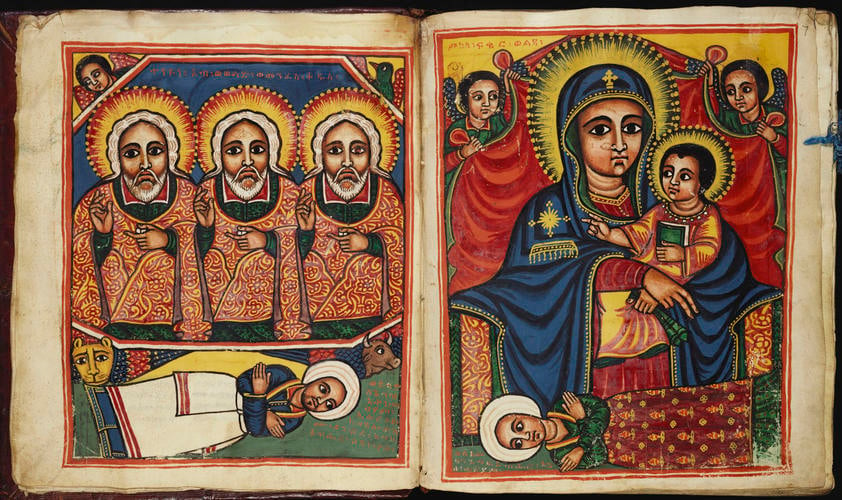The Bible is one of the most influential books in history, shaping cultures, religions, and beliefs worldwide. But did you know that one of the oldest and most original versions of the Bible resides in Ethiopia?
Not only is this Bible ancient, but it also provides compelling evidence that the people of the Bible were Black. In this article, we’ll explore this historical treasure and uncover the rich, untold stories hidden within its pages.
Unearthing the Oldest Bible in Ethiopia
Ethiopia is home to the Garima Gospels, considered one of the world’s oldest and most complete illustrated Christian manuscripts.
Created around the 4th to 7th centuries, these texts predate many other Biblical manuscripts and are housed in the Abba Garima Monastery, located in northern Ethiopia.
This Bible is not just a religious artifact; it is a historical testament that has withstood the test of time, preserving a version of the Biblical narrative that predates many Western texts.
The Ancient Roots of the Ethiopian Bible
The Ethiopian Bible is written in Ge’ez, an ancient Semitic language that is now liturgical in the Ethiopian Orthodox Church.
Unlike other Biblical texts that have undergone numerous translations and edits, the Ethiopian Bible remains remarkably unchanged.
Its content includes books that were excluded from the modern Bible, providing a broader and more complex view of Biblical history.
Evidence of Black People in the Bible
The Garima Gospels and other Ethiopian Biblical texts provide undeniable evidence that many Biblical figures were Black.
The illustrations within these ancient manuscripts depict figures such as Moses, Solomon, and the Queen of Sheba with African features, dark skin, and curly hair.
This depiction aligns with historical accounts of the regions these individuals hailed from, such as Egypt, Ethiopia, and other parts of Africa.
Biblical References to Ethiopia and Cush
Throughout the Bible, there are multiple references to Cush and Ethiopia, regions historically associated with Black African people.
For instance, Numbers 12:1 mentions Moses’ Cushite (Ethiopian) wife, and Psalm 68:31 states, “Princes shall come out of Egypt; Ethiopia shall soon stretch out her hands unto God.”
These references underscore the deep connections between Biblical figures and African civilizations.
Debunking the Myths: The Whitewashing of Biblical History
For centuries, Western interpretations of the Bible have often portrayed Biblical figures as white, influenced by European art and cultural narratives.
Paintings, films, and literature have perpetuated the image of a fair-skinned Jesus, blue-eyed apostles, and a Eurocentric Holy Land.
However, these depictions are far from accurate when viewed against historical and archaeological evidence.
The Impact of Colonialism and Eurocentrism
The narrative that Biblical figures were white gained prominence during colonial times when European powers spread Christianity alongside their empires.
This version of Christianity often came with a Eurocentric retelling of Biblical stories, conveniently erasing the African and Middle Eastern roots of the text.
By highlighting the Ethiopian Bible, we challenge these long-standing myths and restore the historical accuracy of these ancient stories.
The Rediscovery of African Heritage in the Bible
The preservation of the Ethiopian Bible allows modern readers to reconnect with the African roots of Biblical history.
Scholars and historians are increasingly recognizing the importance of Ethiopia in early Christian history, not just as a place of refuge for persecuted Christians but also as a foundational pillar of early Christian thought and tradition.
Ethiopia: A Land of Kings, Prophets, and Biblical Connections
Ethiopia’s significance in Biblical narratives extends beyond the Bible itself. The country is often regarded as one of the earliest Christian nations, with roots that trace back to the Queen of Sheba’s visit to King Solomon, as described in 1 Kings 10.
Ethiopian tradition holds that the Ark of the Covenant is housed in Aksum, further linking the nation’s history with key Biblical events.
Why This Matters: Representation and Historical Truth
The portrayal of Biblical figures as Black is not just about setting the historical record straight—it’s also about representation.
For millions of people of African descent, seeing themselves reflected in the Bible can be a powerful affirmation of their heritage and worth.
It’s a reminder that Black people have always been part of the Biblical narrative, not as outsiders, but as central figures in the unfolding story of faith.
Reclaiming History for Future Generations
Understanding the true origins of Biblical history allows us to pass on a more accurate and inclusive version of these stories to future generations. It empowers us to confront historical inaccuracies and reclaim the diverse legacy that has been overshadowed for too long.
The Ethiopian Orthodox Church has played a critical role in preserving these ancient texts, keeping them safe through centuries of invasions, wars, and religious shifts. The church’s dedication to safeguarding this history ensures that the world can still access these original depictions of Biblical figures.
Conclusion: A Legacy Carved in Ancient Texts
The Ethiopian Bible stands as a testament to the rich and diverse history of the Bible, challenging modern assumptions and restoring the voices of the past.
It is a vivid reminder that the people of the Bible were far more diverse than often portrayed, with deep roots in Africa.
Rediscovering these truths allows us to celebrate a fuller, more inclusive understanding of the Bible’s narrative—one that honors the presence and contributions of Black people throughout history.


